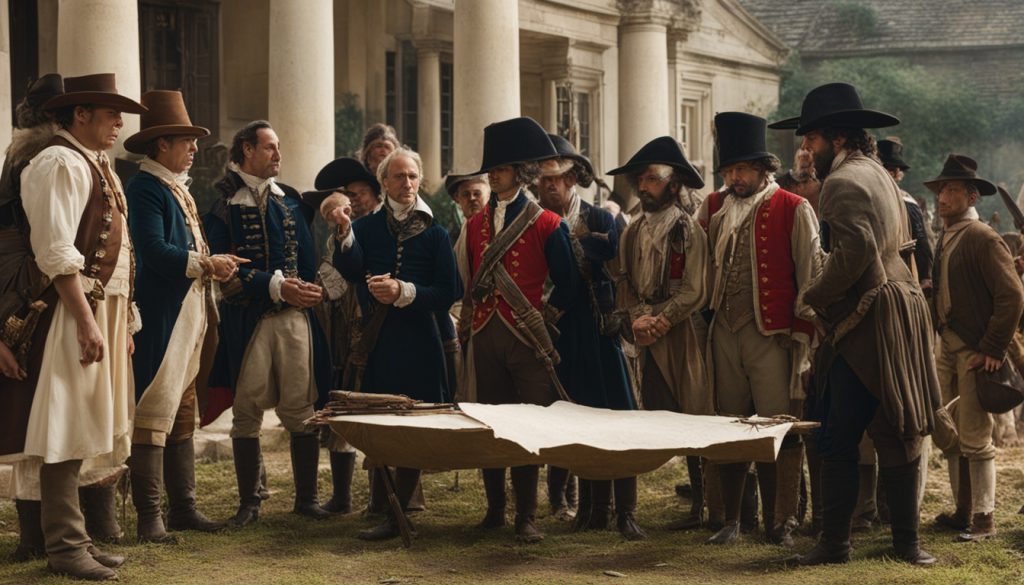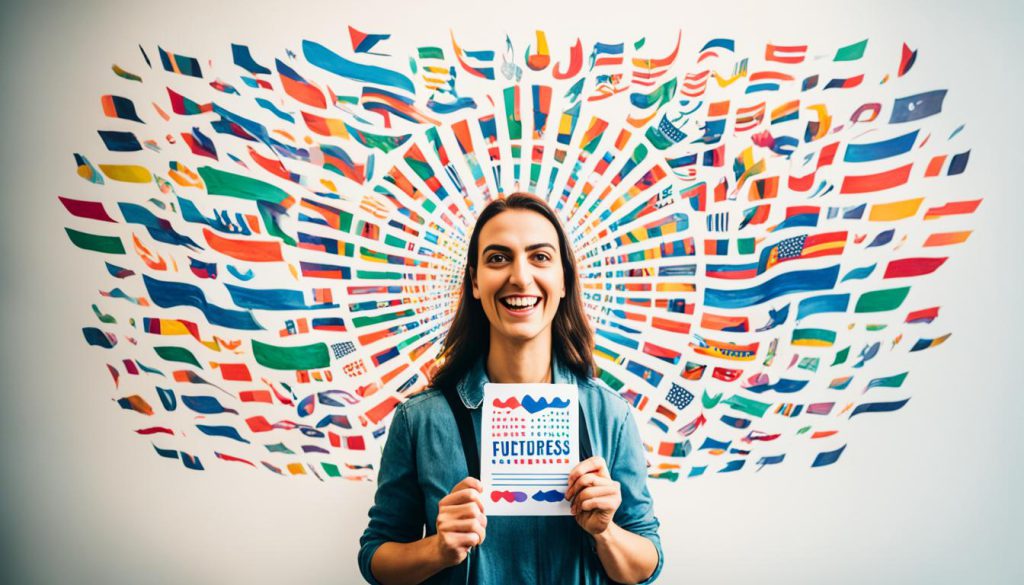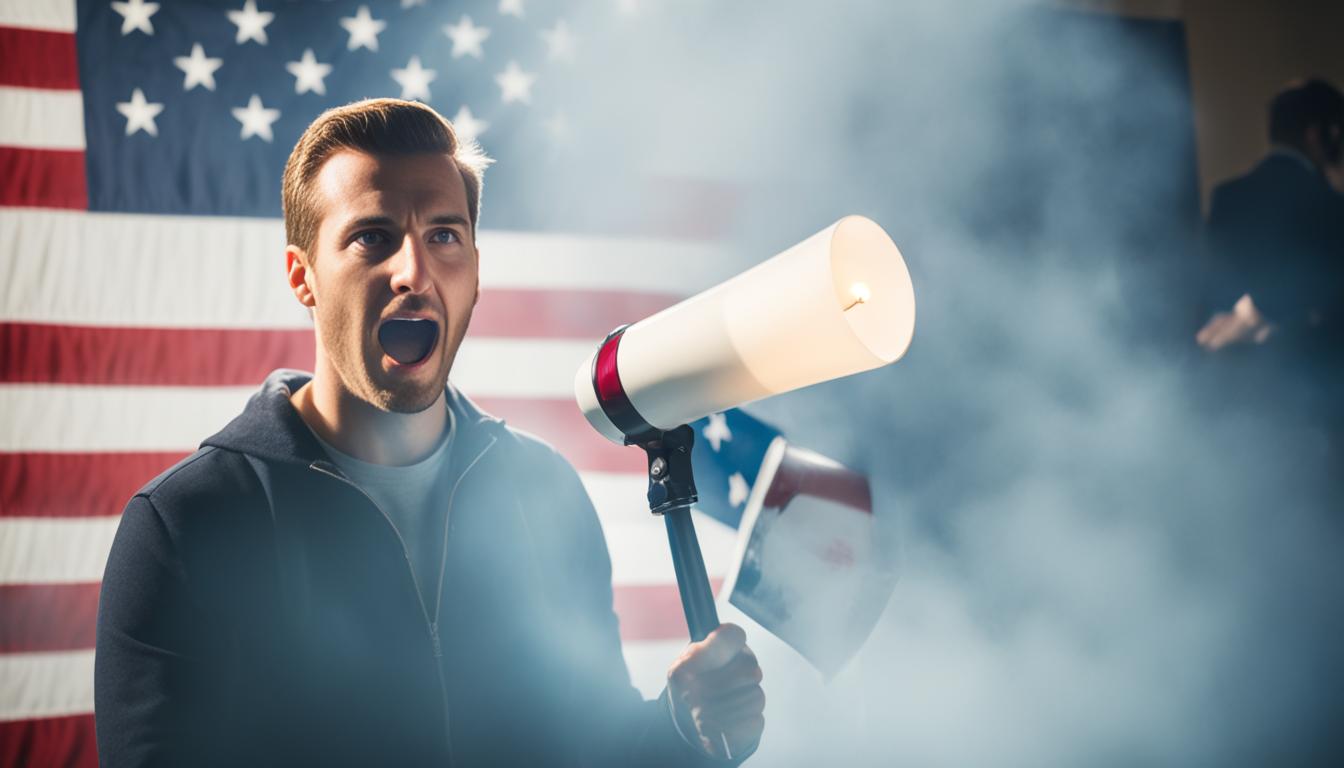Did you know over 90% of Americans see the First Amendment as essential? This comes from the Where America Stands survey. It shows how the Bill of Rights is key to our democracy. The 1st Amendment stops Congress from limiting speech freedom. This right covers many ways to express ourselves. It lets people speak out and engage in politics without fear of government backlash.
The 1st Amendment covers not only speaking but also the right not to. It includes students’ rights, campaign contributions, and advertising. By using these freedoms, Americans have made society more fair. While it mostly limits government power, not private groups, its defense against government efforts to limit beliefs or expression is unmatched.
Picture criticizing government leaders freely, choosing any religion, or reporting on hot topics without fear. This freedom is what the 1st Amendment offers. It’s a major part of American democracy. It ensures we can speak up and contribute to our community.
Key Takeaways
- Over 90% of Americans consider the First Amendment vital to their freedoms.
- The 1st Amendment protects against government control or punishment based on opinions or expressions.
- Five core freedoms are guaranteed: religion, speech, press, assembly, and petition.
- Americans have expanded civil rights through the exercise of these constitutional freedoms.
- Social media platforms have their own policies, but the 1st Amendment restrains only government actions.
Understanding the 1st Amendment
The 1st Amendment of the United States Constitution protects fundamental freedoms. These include speech, religion, press, assembly, and petitioning the government. It became law in 1791, showing the Founders’ commitment to these liberties. This amendment is key for democracy and public discussion.
The Text of the First Amendment
The 1st Amendment’s words are clear and powerful: “Congress shall make no law respecting an establishment of religion, or prohibiting the free exercise thereof; or abridging the freedom of speech, or of the press; or the right of the people peaceably to assemble, and to petition the Government for a redress of grievances.” It supports self-rule and sharing different views. It’s crucial to American society.
Historical Context
The United States Constitution was ratified in 1788, marking a big achievement. But, it lacked promises of personal rights. To gain more support, the Founding Fathers proposed the Bill of Rights. It had 12 amendments initially, but 10 were accepted. These amendments concerned states and protected against government overreach.
Core Freedoms Protected
The First Amendment delineates several core freedoms:
- Freedom of Speech: It’s vital for democracy, allowing people to share thoughts without fear of government action.
- Freedom of Religion: Through specific Clauses, this freedom stops the government from setting a state religion and lets people choose how to worship.
- Freedom of the Press: It enables free discussion on public issues, showing the importance of a free press in democracy.
- Freedom of Assembly: It secures the right to gather for protests, essential for social and political change.
- Right to Petition the Government: It lets people seek solutions to problems and ask the government to address issues.
These rights highlight the value of varied voices, critical discussion, and engaging in governance. The amendment process has made them central to American law and culture.
Historical Background of Free Speech
The story of free speech in early America is a journey towards valuing open conversation. This vision led the Founding Fathers to include protections in the Bill of Rights. They added the First Amendment in 1791 to guard against government control.
Development in Early America
In the nation’s early days, the founding fathers debated a lot about free speech. They were inspired by Enlightenment thoughts and British law. They believed in freedom but agreed that wrong or illegal content should have consequences.
In 1919, the U.S. Supreme Court set the “clear and present danger” rule. This helped balance free speech with national safety. Cases like Schenck v. U.S. showed the fine line between expressing dissent and wartime restrictions.
The Role of the Founding Fathers

The Founding Fathers played a crucial role in framing the First Amendment. James Madison is known as the “Father of the Constitution.” He pushed for clauses on speech and press rights. His ideas led to the amendment we know today, preventing Congress from limiting our freedom to express, gather, and petition.
Acts like the Alien and Sedition Acts, and Thomas Jefferson’s pardons, show how free speech evolved. The dedication of the Founding Fathers to these ideals influenced our laws and the way Americans see freedom.
| Year | Event | Significance |
|---|---|---|
| 1791 | First Amendment Adoption | Part of the Bill of Rights, protecting freedoms of speech, assembly, and worship. |
| 1798 | Alien and Sedition Acts | Led to a libertarian theory on free speech, influencing future jurisprudence. |
| 1868 | 14th Amendment Ratification | Prohibited states from depriving any person of life, liberty, or property without due process. |
| 1919 | “Clear and Present Danger” Standard | Defined government limitations on free speech related to national security and military operations. |
| 1965 | Tinker v. Des Moines | Students’ right to protest (Vietnam War), bolstering free speech protections. |
Key Court Cases Shaping Free Speech
The impact of First Amendment jurisprudence comes from key court cases. These decisions set major precedents. They have shown us how free speech affects society.
Notable Cases
- Schenck v. United States, 249 U.S. 47 (1919): This case brought the “clear and present danger test” for evaluating First Amendment protected speech.
- Whitney v. California, 274 U. S. 357 (1927): It tested the Criminal Syndicalism Act. The court upheld the conviction, not using the First Amendment as defense.
- Near v. Minnesota, 283 U.S. 697 (1931): This important case blocked prior restraints on newspapers, crucial for press freedom.
- Brandenburg v. Ohio, 395 U.S. 444 (1969): It set the modern standard for speech and incitement of lawless action.
- Tinker v. Des Moines Independent Community School District, 393 U.S. 503 (1969): Confirmed that students have free speech rights in schools, like wearing protest armbands.
- Texas v. Johnson, 491 U.S. 397 (1989): Declared flag burning as protected political speech under the First Amendment.
Impact on Society
These cases underline the limits of allowed speech. For example, cases like Evans v. Selma Union High School District of Fresno County and Minarcini v. Strongsville City School District protect literary works as free speech. They guarantee access to varied views. They also update how free speech rights apply to government officials on social media.
Justices including Amy Coney Barrett and Sonia Sotomayor tackled First Amendment issues. They dealt with discrimination based on viewpoint and content. Their decisions balanced free speech protection with keeping order in society. They looked at rules about political clothes and student speech, noting when speech restriction is okay.
Topics like pharmaceutical ads and video game rights were also reviewed. These debates showed the impact of commercial and corporate speech in America. The discussions helped grow First Amendment understanding.
Every ruling added to our knowledge of free speech, showing its changing nature. Courts reviewed content limits and defined unacceptable speech. Their work shapes free speech in the United States today.
Examples of Free Speech Under the 1st Amendment
The 1st Amendment protects different kinds of speech. Let’s look at some important examples:

Symbolic Speech
Symbolic speech is about nonverbal actions that send a message. For example, burning the U.S. flag in protest is a powerful act. It was upheld by the Supreme Court in Texas v. Johnson. This shows that people can use actions to express strong thoughts without speaking.
Political Speech
Political speech is at the heart of the First Amendment. It covers everything from donations to debates. Political speech helps democracy work by making sure all viewpoints are considered. The Supreme Court case, Citizens United v. FEC, protects this kind of speech, highlighting its importance in our country.
Commercial Speech
Commercial speech includes advertising. It is about businesses promoting their goods or services. Though protected, it has stricter rules than other speech types. The Supreme Court’s decision in Central Hudson Gas & Electric Corp. v. Public Service Commission set a standard. It balances freedom of speech with consumer protection.
To sum up, the 1st Amendment covers various speech forms, enriching American freedom of expression. Political, symbolic, and commercial speeches show our democracy’s value on different communication ways.
Limitations of Free Speech
The 1st Amendment offers strong protections but not for all types of speech. There are free speech limitations to keep peace and protect rights. For example, if speech causes illegal acts quickly, it can be banned. This was decided by the Supreme Court in Brandenburg v. Ohio (1969). This incitement rule is for speech that leads to immediate illegal behavior. It’s not protected if it’s likely to cause such actions.
Defamation is another critical limit. Lies that harm someone’s reputation, either written (libel) or spoken (slander), can lead to court. Frauds in speech are illegal too. Obscenity laws, set by the Supreme Court in Miller v. California (1973), limit obscene content. Child pornography is a serious crime. Also, “fighting words” that might cause violence are not protected by the First Amendment.
Racist threats and direct racist insults are not protected either, allowing for lawsuits. Hate speech isn’t always punishable but can be if it leads to violence. Government workers can be penalized for speech that affects their work negatively. School students can be disciplined for disrupting learning or using bad words.
Knowing these free speech limitations is key. It helps us balance the right to speak freely with maintaining order and protecting others. These limits, although debatable, are critical for societal harmony.
The Role of the Amendments in Shaping Free Speech
The U.S. Constitution’s amendments greatly influence free speech understanding and practice. This amendment process has strengthened and often redefined First Amendment rights. Together, they strengthen freedoms and protect individual rights in our democratic society.
Contribution of Other Amendments
The First Amendment covers crucial freedoms like religion, speech, press, assembly, and petition. But, other amendments like the Fourteenth ensure states also respect these rights. The Fifteenth, Nineteenth, and Twenty-Sixth Amendments stop voting discrimination based on race, gender, and age, supporting First Amendment freedoms for all.
Interplay with the 1st Amendment
The constitutional amendments continually shape free speech. Cases like Citizens United v. FEC changed political speech by modifying campaign finance rules. This shows how amendments fine-tune freedom boundaries. Efforts like the Equal Rights Amendment push equality, expanding protected freedoms. By amending the constitution, we support the First Amendment, ensuring free speech keeps up with society and protects basic rights.
The Impact of Social Media on Free Speech
Today, social media is a key tool for sharing ideas and expressing ourselves. It brings up new challenges for free speech, as we figure out how the 1st Amendment fits in the digital world. Major platforms like Facebook, Instagram, Twitter, YouTube, TikTok, Snapchat, Reddit, and LinkedIn set their own rules for what users can post.
Modern Challenges
One big issue is finding the right balance between allowing free speech and stopping harmful content. For example, Facebook fights hate speech by banning slurs and stereotypes. Instagram does something similar with credible threats and hate speech. But this puts them in a tricky spot with users who want fewer limits on what they can say online.
Regulations and Policies
The rules for social media are complicated and keep changing. Sites like LinkedIn and Snapchat are strict about bullying, harassment, and fake news. Recently, Texas and Florida made new laws to keep platforms from blocking users for their political views. This shows how complex the debate about free speech and online moderation is. Courts are still working through these issues, and the Supreme Court is expected to make some key decisions in 2024.
As social media changes how we talk to each other, these platforms have to walk a fine line. They need to encourage open discussion while managing harmful content. The way free speech and social media rules interact will keep changing, reflecting changes in society and technology.
| Platform | Speech Restrictions | Specific Policies |
|---|---|---|
| Hate Speech, Misinformation | Attacks on Protected Characteristics | |
| Credible Threats, Harassment | Targeting Private Individuals | |
| Hate Speech, Bullying | False or Misleading Claims | |
| Identity-based Hate | Communities Promoting Hate | |
| Snapchat | Hate Speech, False Information | Severe Misinformation |
| TikTok | Hateful Behavior, Harassment | Promoting Hateful Ideologies |
| Direct Attacks, Harassment | Encouraging Harassment | |
| YouTube | Hate Speech, Misinformation | Prolonged Insults |
The Global Perspective on Free Speech
Looking at global free speech shows how vital it is for human rights worldwide. Democratic values are key here. A study covering 38 countries found views on free speech vary widely. The global view of the First Amendment helps measure these freedoms.
In the US, 71% support expressing ideas without government control. Plus, 67% stand for the media’s right to report freely. And 69% want open internet access without government blocks. These numbers highlight the US’s strong belief in free speech.
The US leads with a score of 5.73 in a study on speech and press freedom by . Poland is close behind with 5.66. But, places like Senegal score 2.06, and Burkina Faso has 2.94. Other countries scoring low include Jordan, Pakistan, Ukraine, Vietnam, Lebanon, and Japan.
This shows us how global free speech is seen differently around the world. Through the global view of the First Amendment, we see diverse impacts on democratic values and international human rights.
Conclusion
The 1st Amendment is a symbol of freedom at the heart of American values. It keeps the right to free speech safe, making sure our democracy stays alive and well. Defending this right is both a legal duty and a moral need. It shows our commitment to justice and personal freedoms.
Over the years, many court decisions have shown how important this freedom is. They find a balance between being flexible and firm in our laws. For example, important cases mentioned in a study from August 2019 have helped us see how changes in our laws and society’s rules come about. This is detailed in pages 261-272 of a notable academic work.
Standing up for the 1st Amendment is a key part of what makes America, America. It ensures our rights are more than just ideas. They are something we can actually achieve. By supporting these freedoms, we promise to keep our society open to all opinions. This helps democracy grow and keeps free speech as a pillar of who we are.
Source Links
- https://www.freedomforum.org/the-first-amendment/why-you-should-care-about-the-first-amendment/
- https://firstamendment.mtsu.edu/7-things-you-need-to-know-about-the-first-amendment/
- https://www.whitehouse.gov/about-the-white-house/our-government/the-constitution/
- https://www.law.cornell.edu/wex/first_amendment
- https://www.history.com/topics/united-states-constitution/freedom-of-speech
- https://www.law.cornell.edu/constitution-conan/amendment-1/freedom-of-speech-historical-background
- https://firstamendment.mtsu.edu/first-amendment-timeline/
- https://supreme.justia.com/cases-by-topic/free-speech/
- https://www.ala.org/advocacy/intfreedom/censorship/courtcases
- https://www.freedomforum.org/what-speech-is-protected-first-amendment/
- https://www.investopedia.com/terms/f/first-amendment.asp
- https://www.britannica.com/topic/First-Amendment/Permissible-restrictions-on-expression
- https://www.thefire.org/research-learn/limits-free-speech
- https://en.wikipedia.org/wiki/United_States_free_speech_exceptions
- https://freespeechforpeople.org/democracy-amendments/
- https://www.freedomforum.org/free-speech-on-social-media/
- https://firstamendment.mtsu.edu/article/social-media/
- https://www.weforum.org/agenda/2016/11/freedom-of-speech-country-comparison/
- https://academic.oup.com/book/32364/chapter/268637536

